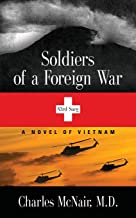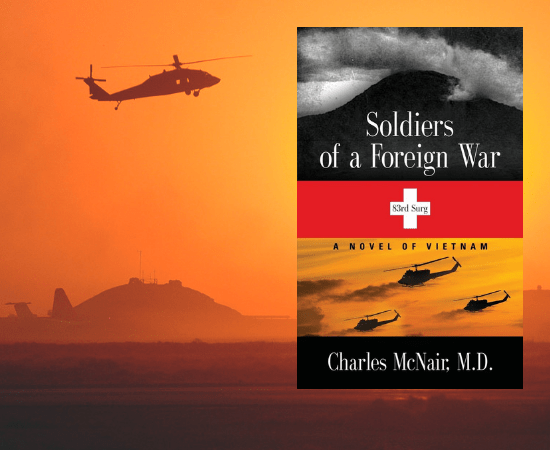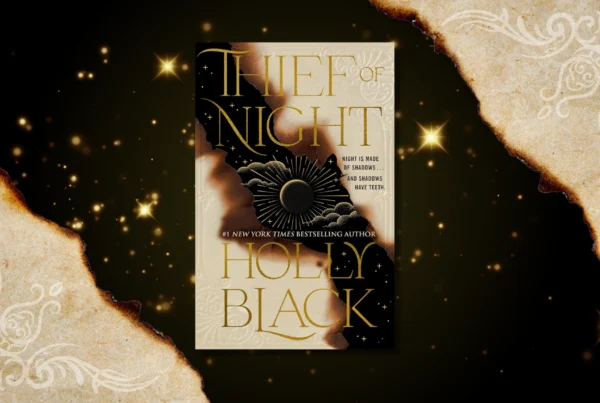Soldiers of a Foreign War by Charles McNair
I wrote Soldiers of a Foreign War so that people could have a new appreciation for the names on the walls of the Vietnam Veterans Memorial. So people could truly connect more personally with the stories of veterans.
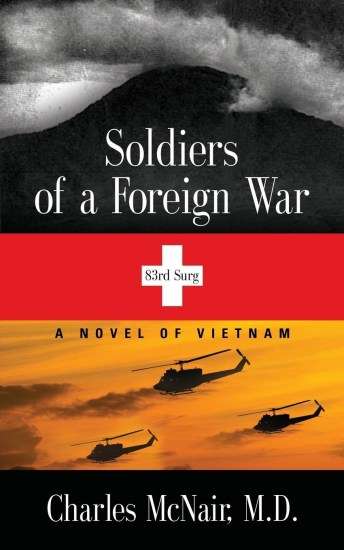 Charles McNair served as an operating room technician in Vietnam, and though it has been many years since his service finished, he thinks of the war every day. Soldiers of a Foreign War meshes McNair’s own experience from the medical side of the war, exposing the stark consequences and brutality of America’s occupation in Vietnam while crafting a thoroughly researched and engaging tale that intersects the lives of many other soldiers of his own creation.
Charles McNair served as an operating room technician in Vietnam, and though it has been many years since his service finished, he thinks of the war every day. Soldiers of a Foreign War meshes McNair’s own experience from the medical side of the war, exposing the stark consequences and brutality of America’s occupation in Vietnam while crafting a thoroughly researched and engaging tale that intersects the lives of many other soldiers of his own creation.
The novel follows a variety of characters including men in two American infantry platoons, a three-man North Vietnamese Army combat cell, and the staff of a small surgical hospital, so readers are exposed to many different perspectives for a more holistic picture of the war.
Perhaps most notably McNair captures the harrowing details of the day-to-day life of a soldier, the similarities among the poor young men fighting despite the side they belonged, and the long-term cost of this grisly chapter in history.
For more on Charles McNair’s writing process, the characters in Soldiers of a Foreign War and his personal experience in Vietnam, read our BookTrib author interview!
![]()
BookTrib: This is your debut novel. Did your writing process go as you envisioned it would?
Charles McNair: Well, I started in 1971 and finished in 2015, so over time the writing evolved. I would go months, maybe even a year without writing anything, and then I would read the last sentence I wrote and pick up where I left off. Originally I wrote it longhand, I think over 1,000 pages I had handwritten. I always thought writing it down slowed my thought process in a good way, and I was able to pick up more stuff.
I wanted to depict the war in a style as true to life and graphic as possible because I thought, perhaps foolishly, that people would read this and think “wow, this is terrible, let’s not do this again.”
BT: You make it clear in your story that many soldiers on both sides were often loyal to their countries, but did not understand or want to participate in the Vietnam war, which is known to have far more of a controversial and hostile reputation than any of its predecessors, even to veterans who returned home. What was your own attitude toward serving?
CM: It was a long war and the perception both stateside and in the country changed over time. I was there ’69-’70 after Nixon was elected to end the war and lied his way into getting reelected. The medics tend to not support any war. Our attitude in the hospital was that it was all a waste. We were killing them, killing ourselves for really what had already been acknowledged by the country as a worthless cause.
So from there, we stopped worrying about the justice of the cause and focused our efforts on keeping each other alive. I was lucky that I was born and raised in San Diego, a big military area, but my family wasn’t a big military family. However, while I was at Vietnam my family moved to Riverside and I came back to an area where I didn’t know anyone. It was a university town and there was a good deal of resistance to the war.
I didn’t go out of my way to make it known that I served. I finished my duty at the Monterrey Hospital for my last 15 months and we had a good support group there. When I was discharged I went back to school. At the surface level, I thought I was fine, but I also noticed that when I was walking across our wide California university campus, instead of walking out in the open and taking the shortest route, I went from tree to tree, an interesting residual trait that still hung from Vietnam. I was there two years before I could cross the quad.
BT: How many of the scenes were direct experiences you encountered and how much of yourself was in one of the prominent medical characters Steve Aiken?
Steve Aiken was largely based off of myself. A lot of those stories were true experiences from either my own service or those of others that were there. For instance, we did have to clean up our hospital for a visiting dignitary, as the characters also were required to do in the book. In real life though, we were asked to move barrels with a bunch of frag holes in them. One sergeant stood up thankfully and said no. When our hospital was under a mortar attack from a Cambodian invasion, those barrels we didn’t end up moving protected me from three frag hits in the chest and ended up saving my life. You always get hit in your first month or last month. That was in my last so I was certainly lucky for those barrels.
The NVA/VC scenes were intuited. All the medical scenes were real. The horrors of triage were also hauntingly true. As medical staff, we had to make hard decisions about who had the best chance of recovery at times while others waited. We had a limited amount of staff members and resources, so unfortunately, good men died waiting while others were operated on, and that was always the most difficult aspect of the job. You had to try and save as many as possible, but that didn’t come without a cost.
BT: Was it a cathartic experience writing this novel?
CM: The war was always on my mind. I would go over the same events over and over again and not get anywhere. The book gave me something direct and productive to show for all my mental wheel spinning. I had big plans with finishing my medical school commitments, so it helped me to focus and gave me a medium of personal expression. Once I started writing the book, everyday experiences would shoot me back to Vietnam. A rainy day with me walking through the puddles would bring back strong memories of how our shoes never dried out between cases. Flashes of memories triggered by visual images became pretty common, but I was able to use those memories and record them.
BT: “They aren’t people, we aren’t people. This can’t be real here.” Some of the hallmarks of Vietnam writing are blunt diction and dehumanization. Newbies may find this cruel, but it seems to be an important coping strategy. Can you expand on this concept and how you address this in your book?
CM: Absolutely. Not just in Vietnam, but in the literature of every war there are derogatory names to call the enemy. The slants, slopes and spicks, there is always a way to dehumanize the enemy. You have to remember that the soldier in any war is not a natural born killer, so you have to find a way to convince him to kill someone. One of the most effective measures to achieve this is by dehumanizing the enemies.
The major difference between the VC/NVA soldier and the American soldier is that the American soldier got to the battleground after a 22-hour jet flight, while the other came through the jungle avoiding air strikes and ambushes. By the time the survivors came to the South, they were already trained pretty well.
BT: Another technique used in your story and many other Vietnam tales is a nonlinear plot, with shifting perspectives and timelines. How do you feel the structure suits the content of the story?
CM: I wanted to cover more aspects of the war than the genre had in the past. One of my top priorities was definitely humanizing the NVA and showing that they were teenage soldiers just like us. I also wanted to expand on the medical side, what actually happened when soldiers were wounded and taken to the hospital. I have a Tolstolien list of characters in this book because I wanted to represent a good deal of names on the memorial walls. None of those names has backstories or families people could see right away. But now these stories give more depth to the meaning and experience, and many of their parts are intertwined.
BT: Another distinction that separates your story from other Vietnam narratives is the shift in perspective from Americans to North Vietnamese Army soldiers (Thuy, Chi, Duan). Contrary to the generic evil enemy “gooks” the Americans are trained to fight, these three are extremely sympathetic characters and ones you grow close to the more you read on them. Why did you choose to include their side in the narrative and present these characters in this fashion?
CM: My approach to people is that 99 percent of them are going to react to something the same way, because we are all intrinsically human. It wasn’t a far stretch to develop the North Vietnamese characters, but I did research how the NVA fought. I also read about the village life in the North under the communists. But that saying is true, “the power of the emperor stops at the village gates.” The power of the Communists and Saigon government ended there, and the North Vietnamese villagers lived much of the same lifestyles as those in the South. They weren’t all political automatons, just like us they fought for each other.
BT: For the Vietnamese, the tunnels can be enterprising for attack and escape. For Americans, a claustrophobic, agonizing experience. Did you ever enter these tunnels personally? How did you obtain these vivid accounts?
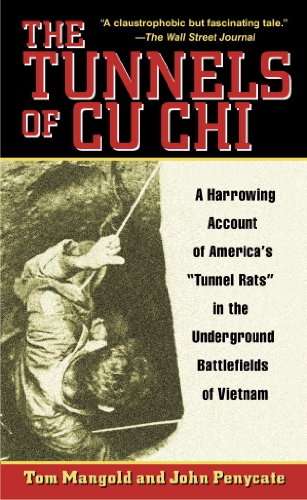 CM: I never was in the tunnels, but what happened was when guys came in for pre-operation, the operating room technicians would begin to assist them. I would talk to men who were “tunnel rats” and described what it was like down there. The Tunnels of Cu-Chi was also a great resource. I got a lot of technical aspects from that book. For sure though, the tunnels were why they would beat us, we never could seem to overcome those.
CM: I never was in the tunnels, but what happened was when guys came in for pre-operation, the operating room technicians would begin to assist them. I would talk to men who were “tunnel rats” and described what it was like down there. The Tunnels of Cu-Chi was also a great resource. I got a lot of technical aspects from that book. For sure though, the tunnels were why they would beat us, we never could seem to overcome those.
When people remark about Soldiers of a Foreign War, usually the first thing they bring up is the tunnels. Our area in Cu-Chi was almost entirely dug under by tunnels and they were never cleared out completely. At any given time someone could pop out of a spider hole, shoot you, and then disappear completely. The 68-Tet utilized those tunnels to infiltrate groups and spring fully formed. As readers will see in the book, the tunnels that Chi discovered were key to the battle of Blackfoot.
BT: What are some books (Vietnam or otherwise) that inspired you to write?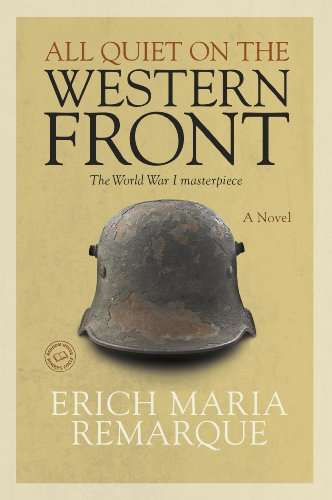
CM: All the classics that talk about war’s effect on the individual. I finished All Quiet on the Western Front in a day when I got back from Vietnam and thought that book would do it. No one would want to go to war after reading this. But of course, we continue to fight, and I hope we learn someday. Red Badge of Courage and From Here to Eternity were also huge. But I would say I wrote more out of self-defense than inspiration.
BT: What are you working on now?
CM: In a breathtaking fit of hubris, I thought I would write a trilogy. It will follow the forebearers of three characters from Soldiers of a Foreign War — Davis, Aiken, and Hanover, based in the Civil War. It’s a tougher plot to run because I’m anchoring it on The Battle of the Wilderness. It was fought May 3-6th in 1864. It’s an interesting battle overseen by Grant; his plan was to sneak around the wilderness and surprise Lee’s troops, but they collided and fought bitterly. Two days of fighting, 29,000 casualties. That will be In a Dark Wood, the first book.
Soldiers of a Foreign War is now available to purchase.
Buy this Book!
Amazon